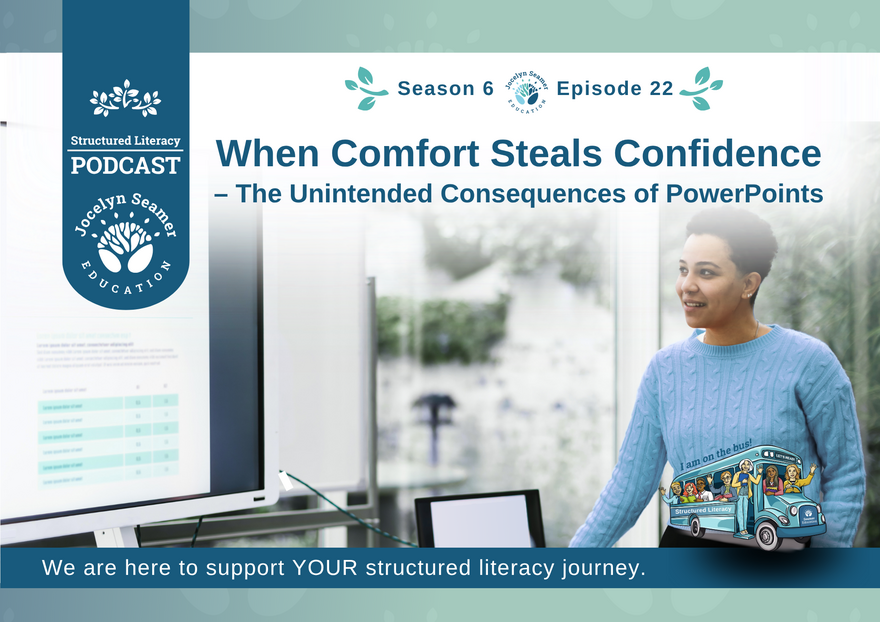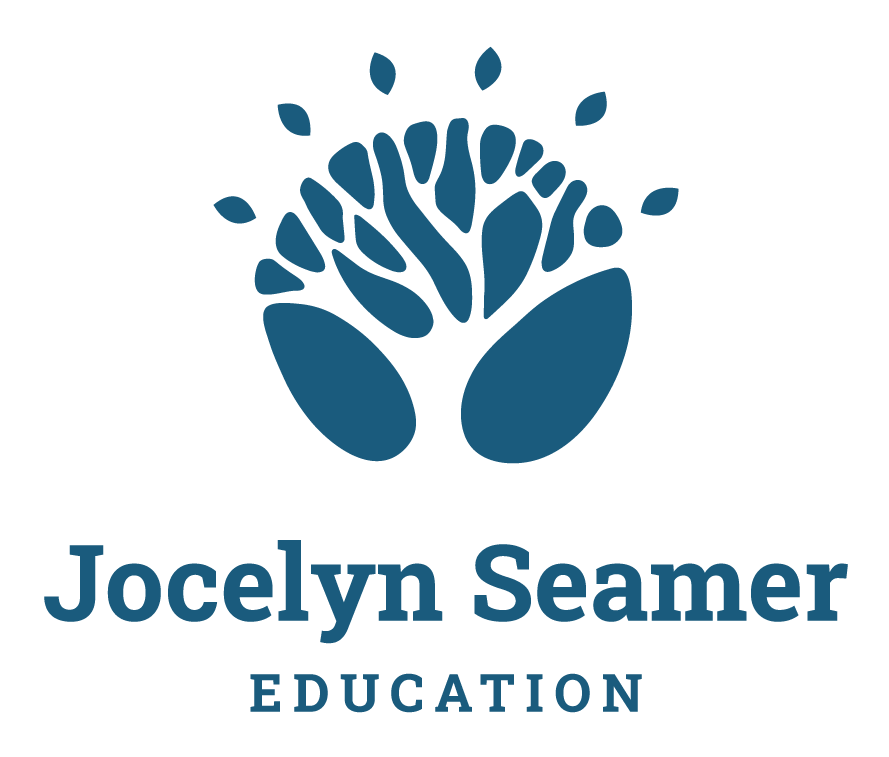S6 E22 - When Comfort Steals Confidence – The Unintended Consequences of PowerPoints

Hi there, welcome to this episode of the Structured Literacy Podcast. I'm Jocelyn and I'm so happy to have you here. I want to start by acknowledging something that's been making headlines recently. The Victorian Department of Education has announced that from 2027, students will be limited to 90 minutes of screen time in Years 3 to 6 and minimal screen time in Foundation to Year 2, beyond what's needed to teach the digital curriculum. This announcement has generated quite a bit of discussion and controversy, as these things naturally do. But I think the intent behind this announcement is genuinely great.
Upcoming Research on Screen Time
There's a growing body of research evidence showing that excessive screen time negatively impacts learning. So much so that we even have researchers like Jared Cooney Horvath bringing out new books on the topic. His book, The Digital Delusion: How Classroom Technology Harms Our Kids' Learning - And How to Help Them Thrive Again, is coming out in early December. Now, just to be clear, I'm not a sponsor of that book. I haven't read the book. I get no money if you look the book up, but I respect the work of Dr. Cooney Horvath and I'm looking forward to reading this one.
While I do have thoughts about students and screens in general, that's actually not what this episode is about, but it has been prompted by the announcement from Victoria. Today I'd like to explore a different aspect of technology use in our classrooms, one that I think is equally important and perhaps even more pressing for teacher capability. I want to talk about the use of PowerPoints as a primary method of content delivery and the unintended consequences of relying on them too heavily in our classrooms.
The COVID Impact
Let's go back in time a little. COVID really did a number on us in education. It created massive disruption, and it also sparked something, which was the widespread adoption of PowerPoints. When we had to be ready to teach online at the click of a button, teams prepared presentations that everyone used. And then, as we transitioned back to the classroom, or stayed in the classroom, as the case may be, we just kept using them. During that time of heightened uncertainty, something interesting happened. Teachers used PowerPoints and felt an extraordinary sense of relief. The cognitive load lifted from the teaching, and that ease, that lightening of burden, became incredibly attractive. It still is.
At the same time, something else was shifting in schools. We were beginning to be aware of the importance of consistency on a large scale. Where previously many schools operated under each teacher's choice about what they taught and how they taught it, schools were moving towards the expectation that everybody teaches the same content in a consistent way. And I'm not criticising that, consistency creates credibility, it builds collective efficacy, it enables collective problem solving. It has many benefits for students.
Yes, We Make PowerPoints
So these two things converged: the use of PowerPoints prompted by COVID, and the drive for consistency. And these two things have remained connected ever since. Now, I want to be transparent, I make PowerPoints. My team creates presentations to help guide teachers through lessons. It's a resource we provide. And while we do it, I'll be honest, I've never been 100% comfortable with it. Yes, having a presentation is the easiest way for us to communicate to a teacher what to do. But I will say that, let's take a text-based unit, for example, so much of that content is for the teacher and does not have to be displayed for the students.
I've always maintained that when we're learning how to teach something, phonics, for example, the learning to teach is incredibly important. Building our capability is a vital factor in our student success. And that's where I want to take us today when we consider this topic.
A Barrier to Teachers
We've all heard criticisms that prepared resources de-skilled teachers, that they remove autonomy, that explicit teaching is somehow bad for both teachers and students. Now, I don't agree with that argument, and if you've been listening to this podcast for any length of time, you know where I stand on evidence-based explicit instruction. But I think we'd be remiss to ignore one part of that critique altogether. Because here's the thing: the ease that PowerPoints bring, the sense of comfort, the lightening of cognitive load, while beneficial in the short term, can actually become a barrier to teachers developing their own capability. I also think that there's confusion, because it seems to me that we're sending the message that explicit teaching is scripted, it does have PowerPoints, that teachers do click buttons. That's not actually what explicit teaching is at its core. Teaching is a thinking process. It requires reflection, it requires adjustment, it requires responsiveness to our students' needs. When success becomes measured by how efficiently we get through the pre-prepared lesson and how quickly we tick boxes, how fast we reach the end of the unit, we miss the actual point. Because the point of instruction is for students to learn. And nobody knows the students in a class like the classroom teacher does. I create programs, yes. My team creates resources, absolutely, but we don't pretend to know your students. We know that you know your students. Our role in this is to give you a guideline for you to follow and adapt as is needed.
When we do too much for someone else, we boost our own confidence by stealing theirs
I heard a saying recently, and it was originally about parenting, but it applies so beautifully here.
When we do too much for someone else, we boost our own confidence by stealing theirs.
I'm gonna let that sink in for a little minute. Cause when I first heard it, I thought, "Whoa, that is a massive Aha! moment." And when I think about it from a teacher development perspective, I have more to add. When we do too much for a learner, and in this case, the teacher is the learner, when we rescue them from discomfort, from effort, from struggle, we steal from them the opportunity to learn. We steal from them the opportunity to develop confidence. Because here's what's true: confidence comes from experience, it comes from saying, "I didn't know that before, but now I do." Confidence comes from overcoming achievable obstacles. Struggle and effort are natural parts of the learning process. And that's not a bug, it's actually a feature. When we create really comfortable conditions for something, when we essentially remove the thinking from the instruction, we also remove the requirement and the opportunity for teachers to learn, regardless of their stage of career.
Scaffolds Can Create Dependence
And let me paint a scenario for you. School leaders tell me regularly that one of their biggest obstacles is supporting their teams to build capability and not become overly reliant on PowerPoints. We all know that scaffolds are supports that need to be removed as soon as possible. If you leave a scaffold in place for too long, whether it be for the adults or the students, it creates dependence. It impedes the learner's ability to think and act for themselves. And here's my big picture concern. We may be creating a whole generation of teachers, and that's anyone who learned to teach first up from 2020 onwards, who don't know what to do when the screen doesn't work. When someone walks in and removes the technology, when there's only a teacher, a whiteboard marker, and a whiteboard, we have to know what to do.
Now, how do we know we have an expert team of teachers? Because an expert has the skill to provide quality instruction when the scaffolds are removed and the context gets a little bit hairy.
Now, I'm not suggesting we should abandon prepared resources entirely. A while back I recorded an episode called Can Great Teaching Be Scripted? And I followed that up with a presentation at the Sydney Morning Herald School Summit with the same title. What I said there was, scripted lessons are like worked examples for novice students. They do lighten cognitive load, they do help you learn the steps, they do help you build fluency with routines, and that's terrific for someone who's beginning the work, whether that be beginning teaching in general or beginning to learn a new way of instruction. But the support that helps a novice doesn't help an expert. And there's something called the worked example effect, and part of that is that the scaffold that helps the novice, the worked example that helps the beginner, actually places greater cognitive burden on the proficient person. Because you have to stop and rethink something that you already do automatically. It puts pressure on your working memory. It actually increases cognitive load.
A Middle Ground
I think there's a middle ground. Let's unpack that. I recognise the benefit of whole school approaches, I think we all do. With a whole school approach, we get collective efficacy, consistency, collective problem solving. These things matter, and I'm not suggesting we abandon them. I'm also not suggesting we provide nothing for teachers to use. There's a step in between the script and hey, it's you and the whiteboard marker. And it reflects how we've always designed our core teaching programs, Reading Success in Action and Spelling Success in Action. That is, fully guided programs with zero requirement for a screen. The teaching is done by the teacher with a whiteboard marker and a whiteboard. The learning is done by the student with hard copy materials. The teacher learns how to teach it and the students learn what they need to. For the teacher, they're learning to formulate the language that's needed, the language use and the steps become internalised, not oursourced. Teachers learn to observe their students and adjust in the moment over time. They learn to think about how to reframe things so that they stick. And it's in that space, the looking the students in the eye, being more active in thinking about language, reflecting on student responses and thinking about how to help them understand that we develop our capability as teachers. It's in the whoopsie-daisies and the mistakes and the errors that the opportunities for growth appear.
As I've said, I'm not saying that we take PowerPoints out entirely, and I'm not saying that we should remove technology from the front of the room. There are absolutely times when screens are fantastic. When we're teaching vocabulary, for example, being able to show students an image or a photo or diagram, you know, that's gold. Illustrating a point in science with a short video clip or drawing something as we unpack an idea, well, that's gold too.
Strengths, Weaknesses, Opportunities, Threats
So I'm suggesting that what we could do as a team is to do a bit of a SWOT analysis of PowerPoints and screen use in the classroom. What are the strengths? What are the weaknesses? What are the opportunities? What are the threats? What you'll likely find is there's consistency across schools in some of the factors. But there'll also be differences based on context. Whether you have a very young staff or a more established one matters. But you don't plan your school's approach based on Jim, Jeremy, and Jenny. You plan for teacher one, two, and three, not knowing who they might be. That's how we create long-term strategic plans that hold up over time.
Have the Conversation
I'm recording this episode as a thought provoker, not as a declarative statement. I'm inviting you and your team to have this conversation, to rumble, as Brene Brown would say, with the complexity of this topic, because it isn't easy to make nuanced decisions for the long term. I absolutely believe that it's within everyone's capability, as a group of professionals, to play out this scenario to various logical conclusions and make some plans. The screen time limits coming into effect in Victoria for 2027 are going to have a real and positive impact on students long term, but they're going to create some real pain points for teachers in the short term. My bold prediction is that student behaviour will get worse before it gets better. Students who are used to looking at screens will find it difficult to focus for a while, and that's ok. With intention and effort, we're going to get them through that. More experienced teachers might say, well, good, we prefer just to teach. And that's because they know how, they have that experience. But for our early career teachers or those who have slipped into the comfort zone of pressing the button on the PowerPoint, this is going to be a significant point of challenge. Not because people aren't intelligent or they're incapable, but because we've potentially begun our careers in a way that has created dependence, or we've leaned into the comfortable space and now we don't want to get out. But it's that dependence that could just be stifling our capability to build our skills as teachers. It's in this point of challenge that there's learning for us in how we support our colleagues and support our teams. It's in having a coach who can talk through what's happened, who can help us reflect, identify patterns, and help us grow in our teaching. We have to invest in the capability building of our staff. That's the number one thing we need to do. Yes, programs are necessary, especially really well-written ones, but the best dollar we invest is the dollar we invest in people.
Teaching While Knowing Human Cognition
This year we've had 15 schools in our Leading Learning Success program working to build a shared vision of what it means to teach in a way that responds to the reality of human cognition that reflects how brains learn. And what we're seeing is so encouraging. Teachers are reflecting and saying things like,
In the past, I'd have my students open their laptop the moment they walked in, and then I'd spend forever trying to get their attention. Even when I did, their eyes were still on the screen. Now the laptop stays closed at the start of the lesson. We begin with full attention.
And that's from a secondary teacher. Now that shift that we're seeing, that's capability building.
It's so easy to fall into black and white thinking and black and white discussions when it comes to issues like technology. But let's not slide into tech versus no tech, PowerPoint versus no PowerPoints, and into those pendulum-swinging discussions that always end up in us missing the point. Let's have the nuanced conversation with our teams, with our leadership groups, and with each other about what this means for our students and for us as teachers. Remember that the end goal is not that you followed the steps precisely according to what was on the page. That might be where we start. But the end goal of instruction is student outcomes and student learning. We are the engineers of success for our kids. And leaders, we're the engineers of success for our teams, to work with them, to create the conditions that enable them to lean in and invest themselves for their own development.
Teachers Are Capable
So let's prioritise capability building for our teachers and our students so that we can help create the future we know is absolutely possible. I believe strongly in the capability of teachers and the promise of our profession. Let's keep our eye on that. Let's create expert teams of teachers who can teach brilliantly whether there's a screen in the room or not. And as I've said, since I've worked in the desert in the Northern Territory, you can teach a child to read and write with a stick in the dirt if you have to. Let's be thankful that we don't. Thanks so much for listening to this episode. I can't wait to bring you more of the Structured Literacy Podcast. Until next time, happy teaching, everyone. Bye.
Show Notes:
S4 Ep3 - Can Great Teaching Be Scripted?
Looking for a 12-month coaching and PL partnership to learn how to build teacher capability? Find out more here.


 Jocelyn Seamer Education
Jocelyn Seamer Education
0 comments
Leave a comment